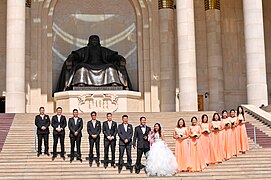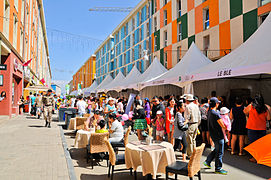Some day I'll visit. Apparently this is a good jumping off point for Dornod, a grassland area with lots of gazelles. you can travel here by jeep or by bus. The Mongolian Natural History Museum has dinosaur fossils.
Ulaanbaatar
Mainstream tourist guide books usually recommend the Gandantegchinlen Monastery with the large Janraisig statue, the socialist monument complex at Zaisan Memorial with its great view over the city, the Winter Palace of the Bogd Khan, Sükhbaatar Square and the nearby Choijin Lama Temple.
- Wedding at the Sükhbaatar Square.
- International Food Festival held annually in UB in September.
- Zaisan Memorial is dedicated to the Russian and Mongolian war hero.
- The Sükhbaatar Square and Mongolian Parliament.
- One of many events in the city. (Shown here, Naadam)
- Equestrian statue of Genghis Khan.
- Aryabal Meditation Center at Gorkhi-Terelj National Park.
- Street art at UB's Peace Avenue
- The Beatles monuments is a popular place for the youth of UB to gather around.
- Khustain Nuruu National Park, home of the wild horse Takhi, is just 90 kilometres (56 miles) west of UB.
Ulaanbaatar is located at about 1,350 metres (4,430 ft) above mean sea level, slightly east of the centre of Mongolia on the Tuul River, a sub-tributary of the Selenge, in a valley at the foot of the mountain Bogd Khan Uul. Bogd Khan Uul is a broad, heavily forested mountain rising 2,250 metres (7,380 ft) to the south of Ulaanbaatar. It forms the boundary between the steppe zone to the south and the forest-steppe zone to the north.
Your notes (private)
What's on your mind? (you can type here notes just for you and they will show on your dashboard)
Information for getting there
When someday comes you'll need to get in.
Information for getting around
When someday comes you'll need to be able to get around.
Your tips and questions
Let us know your best tips about Ulaanbaatar.










